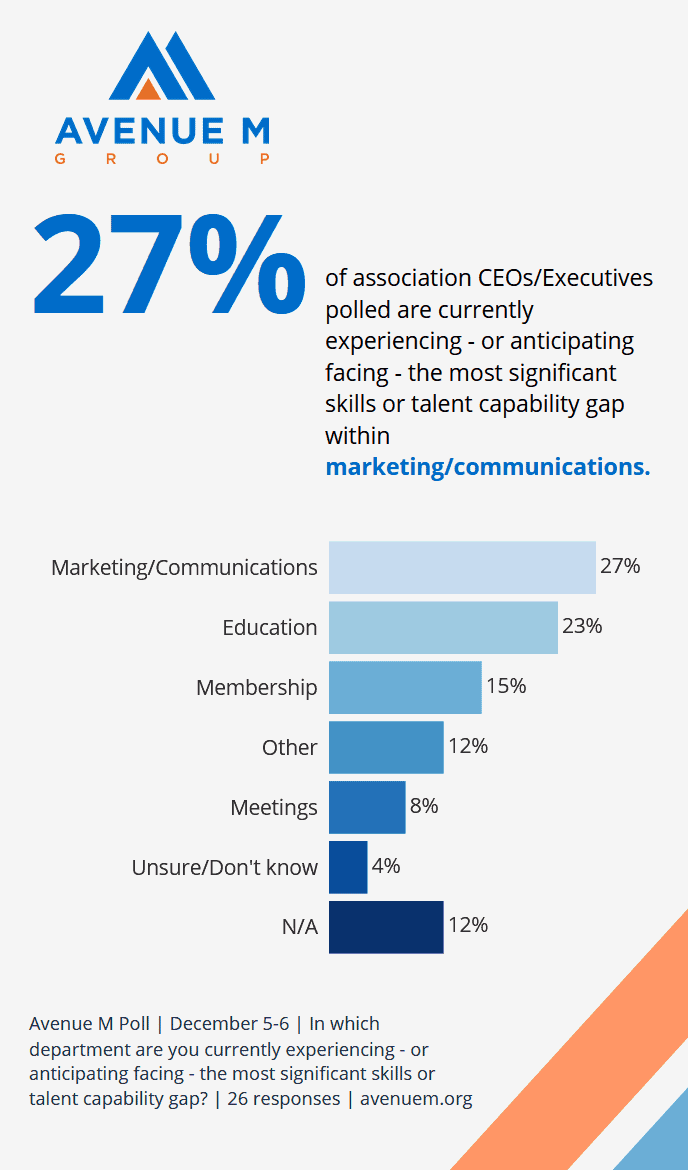The rise of AI and other tech trends is prompting associations to focus intently on elevating their communications, education, and membership departments, gearing up to tackle a fresh set of challenges.
As technologies and trends evolve at a lightning pace—with AI being the obvious disruptor—associations must adapt to remain relevant. Addressing skills gaps allows organizations to navigate new platforms, tools, and strategies, ensuring that their messages are meaningful and resonate broadly.
Also key, especially in the current uncertain economic climate, is matching top talent to the highest-value roles. McKinsey research shows that, in many organizations, between 20 and 30 percent of critical roles aren’t filled by the most appropriate people.
But that doesn’t always mean looking outside the organization. In 2022, “quiet quitting” was a phenomenon. Now, in 2023, shrewd organizations are flipping this with “quiet hiring,” according to Harvard Business Review. That means encouraging staff to switch roles where needed, giving bonuses or promotions, offering learning opportunities, and bringing in specific skills through methods like alumni networks or gig workers—all without hiring more full-time staff.

When association executives were asked in which departments they are facing—or expect to face—major skills or talent capability gaps, 27 percent said marketing/communications, 23 percent said education, 15 percent said membership, and only 8 percent said meetings, according to an Avenue M text poll.
They are considering proactive steps to address these skills or talent gaps. One executive, whose organization is focusing on education, said, “We increased our professional development allowance for staff in 2024 and are including continuing education as a specific item that staff must report on during their quarterly performance conversations.”
Another leader, also looking at education, said their group is “exploring outside expertise to fill the gap.”
An executive who is centered on membership said their organization plans an “audit of the department and a process to determine gaps.” One leader, also focused on membership, said they are concentrating on staff development and filling open positions with prospects that have the necessary skills.
And one leader, who said they are not planning updates now because they are in a “good place” in terms of skills and talent, said they anticipate that everyone across the association will need to learn new skills in AI, noting that “learning new skills around AI isn’t just for IT but for everyone!”
Getting staff up to speed on AI is a good plan—no matter an organization’s size. Notably, Amazon said it is launching “AI Ready,” a program to train two million workers in artificial intelligence skills by 2025 to keep pace with its competitors Microsoft and Google. The initiative offers free online courses for both beginners and experienced staff members aimed at addressing the industry’s skills gap, according to The Wall Street Journal.
Concentrating on talent and skills gaps isn’t just a survival strategy—it’s investing in staff to help them meet any challenge. Associations that proactively cultivate a dynamic workforce are setting themselves up for enduring sustainability—agile and responsive for whatever comes their way.
Want to participate in future text polls? You can sign up HERE.
For more insights on closing skills and capability gaps, read Avenue M’s quick summaries of the following resources, and click the links below.
Hit The Ground Running: How to Bridge the Skills Gap Between Education and Work
Good leadership skills are vital for success at work, and special training programs can help improve them. A 2022 survey found that 83 percent of employers are currently dealing with employees who lack important soft skills. Additionally, 78 percent anticipate facing a skills gap in the future.
- Communication: Learn and practice effective communication.
- Management: Get insights for better teamwork and cooperation.
- Problem-Solving: Learn how to solve problems strategically.
- Planning: Understand how to plan goals and manage time, especially useful for remote work.
These skills are essential for excelling in the workplace, and participation in leadership training makes the learning process smoother. It serves as a bridge to address the skills gap effectively, enhancing the likelihood of professional success.
How to Address the Skills Gap
Some ideas for building a diverse and skilled team include: prioritizing needed skills in resumes, looking for qualities like drive and loyalty, promoting a learning culture, considering diversity beyond race and gender, and being open to resumes from career changers by evaluating their skills and experiences creatively.
Considering today’s talent challenges, employers can tap into nontraditional and diverse talent pools, including older workers with valuable experience, individuals with criminal backgrounds through second chance hiring, candidates with disabilities for enhanced productivity and inclusivity, and global talent for specialized positions, potentially expediting the recruitment process.
Want to be the first to be notified about articles like this? You can learn more about Avenue M’s texting poll service HERE.
Contributors: Sheri Jacobs, FASAE, CAE & Lisa Boylan
Image: